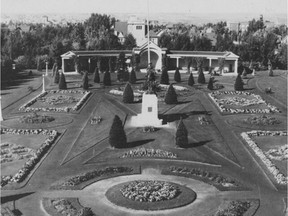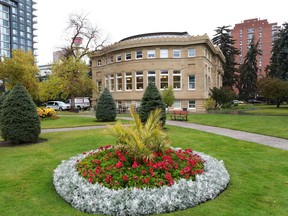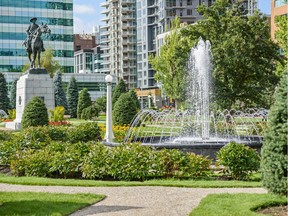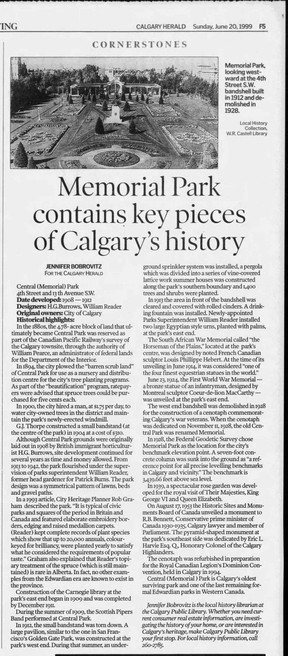

Article content
As the local history librarian at the Calgary Public Library, Jennifer Bobrovitz wrote a weekly column for the Calgary Herald in the 1990s called Cornerstones. It explored the stories behind historic buildings and sites in Calgary, present and past. This column about Central (Memorial) Park was first published June 20, 1999.
Central (Memorial) Park
Article content
By Jennifer Bobrovitz
Advertisement 2
Article content
4th Street and 13 th Avenue S.W.
Date developed: 1908-1912
Designers: H.G.Burrows, William Reader
Original owners: City of Calgary
Historical highlights:
In the 1880s, the 4.78- acre block of land that ultimately became Central Park was reserved as part of the Canadian Pacific Railway’s survey of the Calgary townsite, through the authority of William Pearce, an administrator of federal lands for the Department of the Interior.
In 1894, the city plowed the ”barren scrub land” of Central Park for use as a nursery and distribution centre for the city’s tree planting programs. As part of the ”beautification” program, ratepayers were advised that spruce trees could be purchased for five cents each.
In 1900, the city hired a man, at $1.75 per day, to water city-owned trees in the district and maintain the park’s newly-erected windmill.
G.J. Thorpe constructed a small bandstand (at the centre of the park) in 1904 at a cost of $310.
Although Central Park grounds were originally laid out in 1908 by British immigrant horticulturist H.G. Burrows, site development continued for several years as time and money allowed. From 1913 to 1942, the park flourished under the supervision of parks superintendent William Reader, former head gardener for Patrick Burns. The park design was a symmetrical pattern of lawns, beds and gravel paths.
Article content
Advertisement 3
Article content
In a 1993 article, City Heritage Planner Rob Graham described the park. ”It is typical of civic parks and squares of the period in Britain and Canada and featured elaborate embroidery borders, edging and raised medallion carpets. (Reader) kept complete records of plant species which show that up to 20,000 annuals, colour-keyed for brilliancy, were planted yearly to satisfy what he considered the requirements of popular taste.” Graham also explained that Reader’s topiary treatment of the spruce (which is still maintained) is rare in Alberta. In fact, no other examples from the Edwardian era are known to exist in the province.
Construction of the Carnegie library at the park’s east end began in 1909 and was completed by December 1911.

During the summer of 1909, the Scottish Pipers Band performed at Central Park.
In 1912, the small bandstand was torn down. A large pavilion, similar to the one in San Francisco’s Golden Gate Park, was constructed at the park’s west end. During that summer, an underground sprinkler system was installed, a pergola which was divided into a series of vine-covered lattice work summer houses was constructed along the park’s southern boundary and 1,400 trees and shrubs were planted.
Advertisement 4
Article content
In 1913 the area in front of the bandshell was cleared and covered with rolled cinders. A drinking fountain was installed. Newly-appointed Parks Superintendent William Reader installed two large Egyptian style urns, planted with palms, at the park’s east end.
The South African War Memorial called ”the Horseman of the Plains,” located at the park’s centre, was designed by noted French Canadian sculptor Louis Phillippe Hebert. At the time of its unveiling in June 1914, it was considered ”one of the four finest equestrian statues in the world.”
June 23, 1924, the First World War Memorial — a bronze statue of an infantryman, designed by Montreal sculptor Coeur-de-lion MacCarthy — was unveiled at the park’s east end.
The west end bandshell was demolished in 1928 for the construction of a cenotaph commemorating Calgary’s war veterans. When the cenotaph was dedicated on November 11, 1928, the old Central Park was renamed Memorial.
In 1928, the Federal Geodetic Survey chose Memorial Park as the location for the city’s benchmark elevation point. A seven-foot concrete column was sunk into the ground as ”a reference point for all precise levelling benchmarks in Calgary and vicinity.” The benchmark is 3,439.66 feet above sea level.
Advertisement 5
Article content
In 1939, a spectacular rose garden was developed for the royal visit of Their Majesties, King George VI and Queen Elizabeth.
On August 17, 1953 the Historic Sites and Monuments Board of Canada unveiled a monument to R.B. Bennett, Conservative prime minister of Canada 1930-1935, Calgary lawyer and member of Parliament. The pyramid-shaped monument at the park’s southeast side was dedicated by Eric L. Harvie Esq. Q., Honorary Colonel of the Calgary Highlanders.
The cenotaph was refurbished in preparation for the Royal Canadian Legion’s Dominion Convention, held in Calgary in 1994.
Central (Memorial ) Park is Calgary’s oldest surviving park and one of the last remaining formal Edwardian parks in Western Canada.


Article content